Geoff Nicholson's Blog, page 35
August 23, 2018
WALKING UNCAGED
There are many days when I wish that John Cage was still with us, for his compositions and his philosophy, and on a day like today, his mycological skills. Cage was a mushroom hunter, an activity that requires a fair bit of walking, and he wrote in a somewhat ironic piece published as “Music Lover’s Field Companion,” “I have spent many pleasant hours in the woods conducting performances of my silent piece, transcriptions, that is, for an audience of myself, since they were much longer than the popular length which I have had published.”
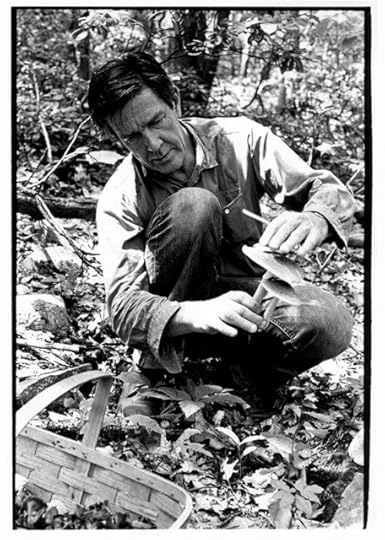
He even taught a class in mushroom identification at the New School in New York which involved taking the class, on foraging expeditions, walking through the woods, but (the school decreed) only those woods accessible on public transport.
Cage has been on my mind because recently as I’ve walked around LA (a city which has scarcely seen a trickle of rain for the last several months), I keep seeing mushrooms and fungi growing in very unexpected places. Such as here on somebody’s lawn in Larchmont:

I suppose in this case the lawn has been watered perhaps overwatered through this long dry spell, and so perfect mushroom conditions have been created.
I suppose this must apply in the case below too, in Sawtelle, though this isn’t somebody’s garden but one of those little strips of grass between the road and the sidewalk. I didn’t notice a sprinkler system but I guess there must be one. And in fact that mushroom was even bigger than it looks in the photo.
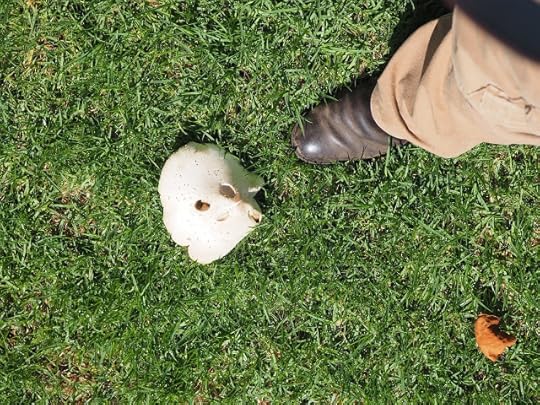
And today, on my way to the dentist, I saw this (there were a couple of other very small, less impressive specimens near by):
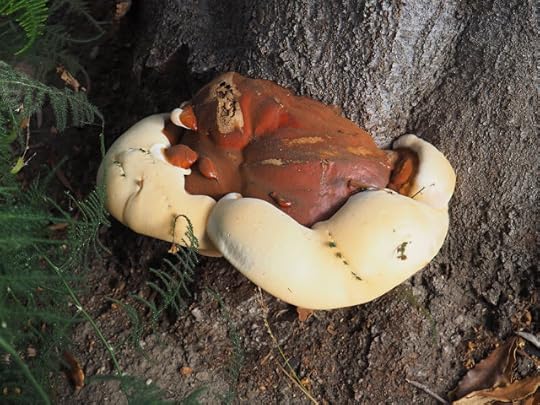
Since they’re growing out of the tree I don’t suppose they rely on watering, and the patch of ground the tree did look very dry, though that’s not to say it doesn’t get watered from time to time. I wish John Cage, or someone, had been there to identify the fungus. My best guess, from doing a reverse image search, is that it might be a Rhizina undulate, but I wouldn't want to put money on it.
Did you know that in 1959 Cage won $10,000 on an Italian quiz show Lascia o Raddoppia (Double or Nothing) by giving the 24 names of the white-spored Agaricus as described in Atkinson’s Studies of American Fungi.” Not just that, he listed them in alphabetical order,” which makes him a bit of a show- off, but when you’ve got the knowledge, why not flaunt it? He used the prize money to buy a piano and a Volkswagen bus Merce Cunningham's dance company. It wasn’t the sixties, but it was close. In 1969 Cunningham produced a dance piece titled Walkaround Time.
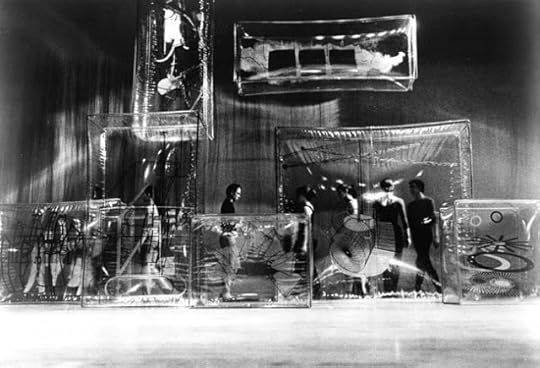


He even taught a class in mushroom identification at the New School in New York which involved taking the class, on foraging expeditions, walking through the woods, but (the school decreed) only those woods accessible on public transport.
Cage has been on my mind because recently as I’ve walked around LA (a city which has scarcely seen a trickle of rain for the last several months), I keep seeing mushrooms and fungi growing in very unexpected places. Such as here on somebody’s lawn in Larchmont:

I suppose in this case the lawn has been watered perhaps overwatered through this long dry spell, and so perfect mushroom conditions have been created.
I suppose this must apply in the case below too, in Sawtelle, though this isn’t somebody’s garden but one of those little strips of grass between the road and the sidewalk. I didn’t notice a sprinkler system but I guess there must be one. And in fact that mushroom was even bigger than it looks in the photo.

And today, on my way to the dentist, I saw this (there were a couple of other very small, less impressive specimens near by):

Since they’re growing out of the tree I don’t suppose they rely on watering, and the patch of ground the tree did look very dry, though that’s not to say it doesn’t get watered from time to time. I wish John Cage, or someone, had been there to identify the fungus. My best guess, from doing a reverse image search, is that it might be a Rhizina undulate, but I wouldn't want to put money on it.
Did you know that in 1959 Cage won $10,000 on an Italian quiz show Lascia o Raddoppia (Double or Nothing) by giving the 24 names of the white-spored Agaricus as described in Atkinson’s Studies of American Fungi.” Not just that, he listed them in alphabetical order,” which makes him a bit of a show- off, but when you’ve got the knowledge, why not flaunt it? He used the prize money to buy a piano and a Volkswagen bus Merce Cunningham's dance company. It wasn’t the sixties, but it was close. In 1969 Cunningham produced a dance piece titled Walkaround Time.


Published on August 23, 2018 14:09
August 16, 2018
WALKING WITH OBELISKS
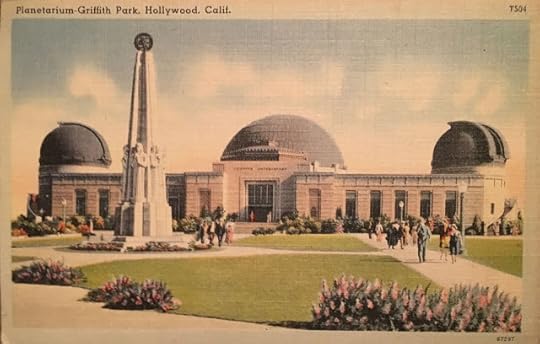
I’ve been walking, and thinking about obelisks. If you walk a couple of miles, all of them up hill, from where I am now in East Hollywood, you’ll come to the Griffith Park Observatory, and outside it you’ll find this:
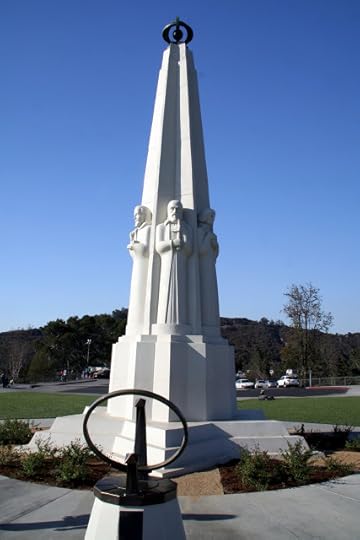
It’s sometimes known as the Griffith Observatory Obelisk, sometimes as the Astronomers' Monument, designed by Archibald Garner, completed in 1934 even before the opening of the observatory, about 40 feet tall, with figures of Hipparchus, Copernicus, Galileo, Kepler, Newton, and Herschel at the base. (I admit that I’d never heard of Hipparchus.)
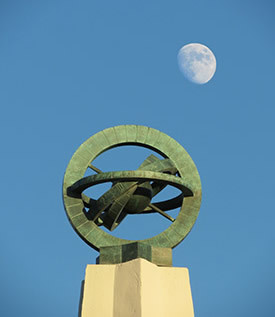
Those statues and the armillary sphere on top give it a rather more complex design than I think an obelisk should have, though I’m not knocking it. But if you head down the road to the Hollywood Forever Cemetery you’ll find (what seem to me at a least) purer examples of the breed, such as this one marking the grave of Griffith J, Griffith, the very man that Griffith Park is named after.
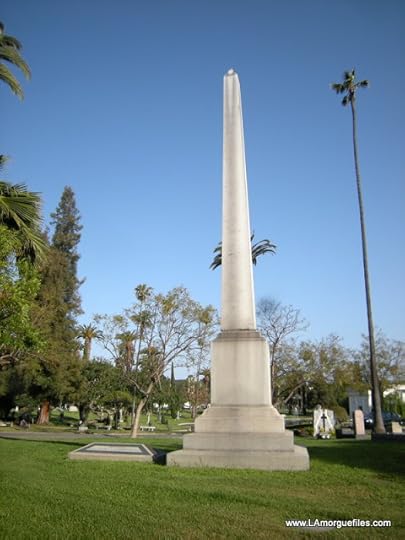
Further south still, on the University of Southern California campus, you’ll find a line of comparatively short obelisks, each about nine feet tall, which mark the involvement of students and faculty in the 1984 Los Angeles Olympics.

So clearly Los Angeles has its shared of obelisks even if it’s not exactly famous for them. London on the other hand, has loads, as I found out recently.
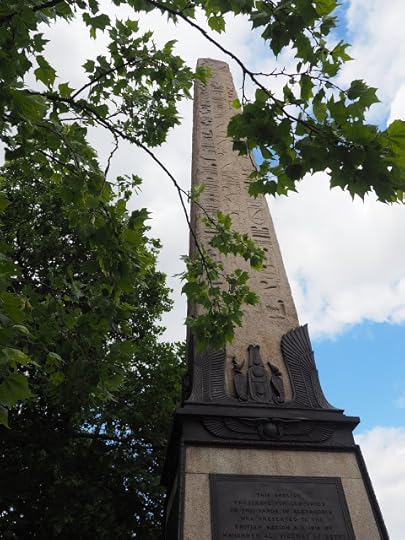
The "biggie" of course is Cleopatra’s Needle on the Embankment (above), a genuine Egyptian obelisk, and that’s a whole obsession in itself, especially how they got it to England: in an iron tube that was 90 feet long – the obelisk itself being about 70 – and they built an ocean-going vessel around it so it could towed all the way from Egypt. Complications, some of them lethal, ensued.
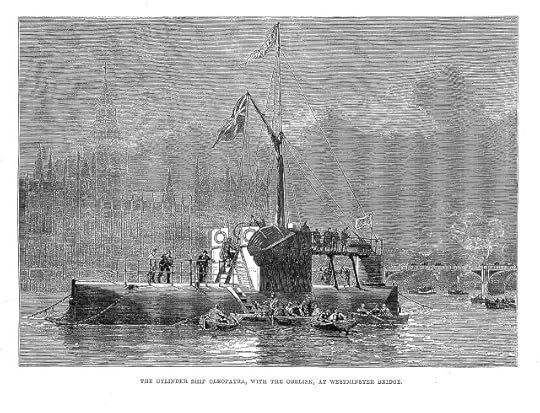
I didn’t know any of this story until very recently, and asking around my acquaintances, many of whom like to think they’re pretty knowledgeable, none of them did either.
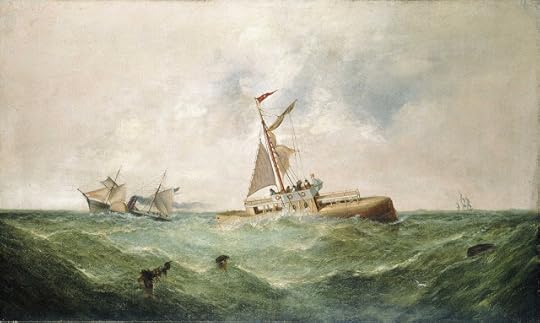
Once you start keeping your eyes open for obelisks, London seems to be full of them, and again some look more perfect examples than others. I saw obelisks in Chelsea:
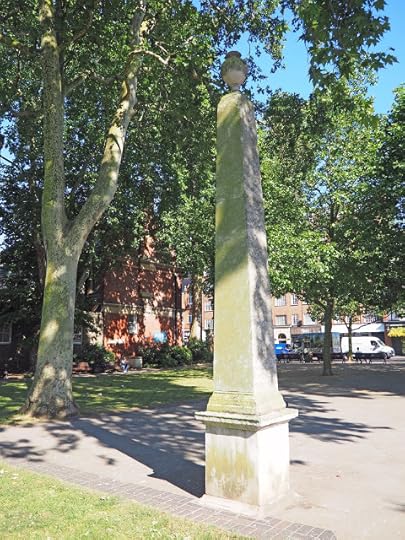
West Hampstead:
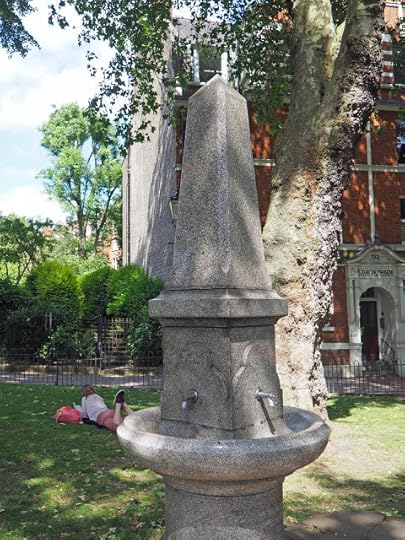
Saville Row:
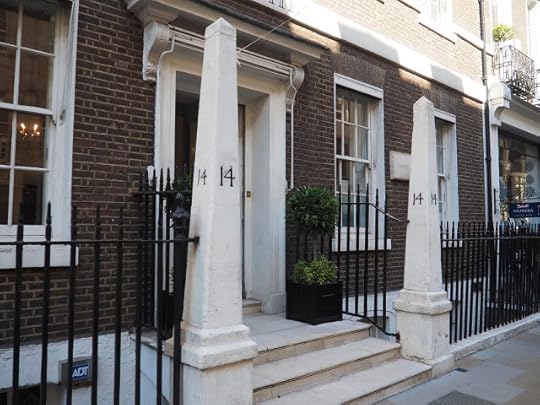
In an antique shop in Mayfair

And outside of London too, such as this rather wonderful one in Mistley, in Essex. Those are the Mistley Towers behind it, and there’s an inscription on the obelisk commemorating a local woman named Jane Death. I kid you not.
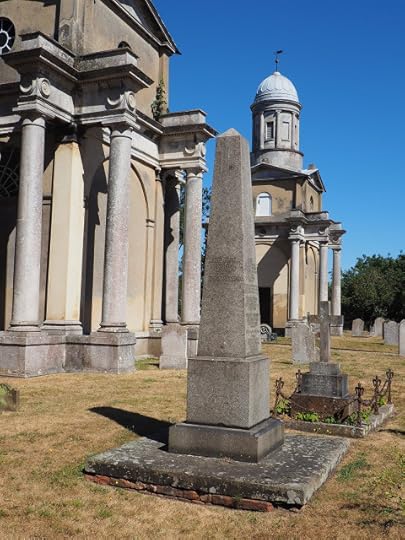
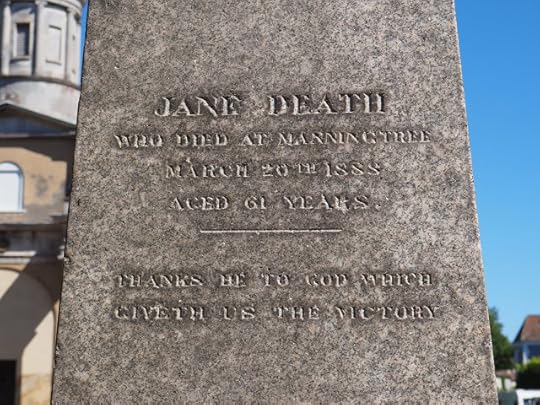
I also realized that I’d photographed obelisks in the past, while out walking, without really thinking about it much. This one in Bristol:
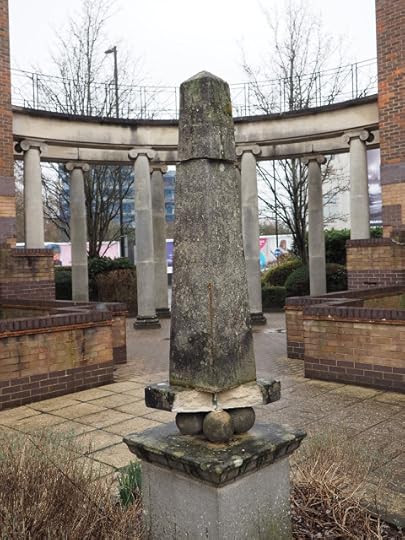
There is also this especially fine obelisk on a crazy golf course in Great Yarmouth.
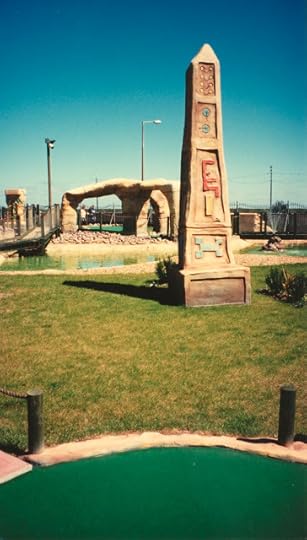
And I know that years ago I was in Washington DC and definitely saw the Washington Monument. This is the tallest obelisk in the world, 555 feet high, completed in 1844 – there is much discussion about whether or not slave labor was used. In any case, I only saw it from a distance, and I was young and unimpressionable back then. There is also an argument that it isn’t a true obelisk, which should be made from one piece of stone – impossible given the size, and also given that there is currently an elevator inside.
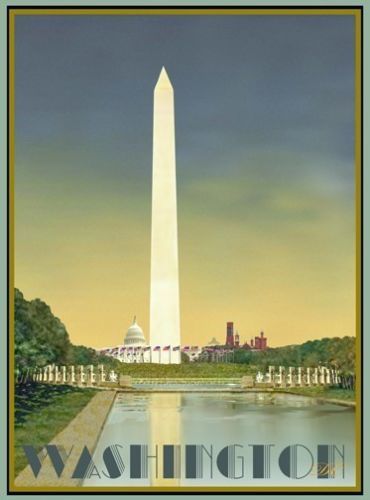
And if you’re a conspiracy theorist you’ll be thrilled to see this:

And finally (at least for now, I mean this obsession is only just starting, I haven’t even started on Athanasius Kircher) there is this by the great illustrator Tom Gauld.

It’s a myriorama “inspired by the works of Laurence Sterne, and I’m actually not sure If that walking figure is Sterne or Tristan Shandy, but that’s very definitely an obelisk. Now, there is no mention of an obelisk in Tristram Shandythough there’s plenty of walking, nor is there an obelisk mentioned in A Sentimental Journey,so this may be an indication of Mr. Gould’s own obelisk obsession.
I have, however found a reference to an obelisk in Sterne’s writing. It appears in Sermon XVIII titled “The Levite and his Concubine” and runs as follows:“Certainly there is a difference between Bitterness and Saltness, that is, between the malignity and the festivity of wit, the one is a mere quickness of apprehension, void of humanity, and is a talent of the devil; the other comes from the Father of spirits, so pure and abstracted from persons, that willingly it hurts no man : or if it touches upon an indecorum, 'tis with that dexterity of true genius, which enables him rather to give a new colour to the absurdity, and let it pass. He may smile at the shape of the obelisk raised to another's fame, but the malignant wit will level it at once with the ground, and build his own upon the ruins of it.” Wit, obelisks, ruins – my kind of sermon.

Published on August 16, 2018 14:12
August 10, 2018
THE ONE WORLD MISALLIANCE
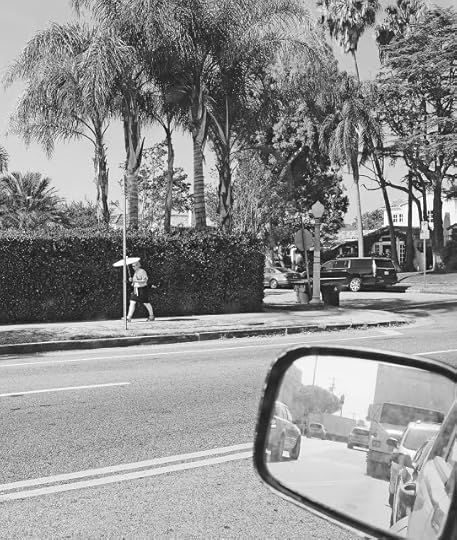
I’ve been back in LA, from England, for about a month now, and in truth I haven’t been doing very much walking. When the temperature reaches 90 every day (and yesterday it was 97 – that’s 36 degrees for lovers of Centigrade) it rather takes the spring out of your step.
But I haven’t been completely sedentary, and sometimes you just have to get out there, sweat it out, and walk the hot streets. and while I’ve been doing it I’ve thought to myself, yep, I’m back, this is all very, very LA.
The classic Volkswagen beetles:
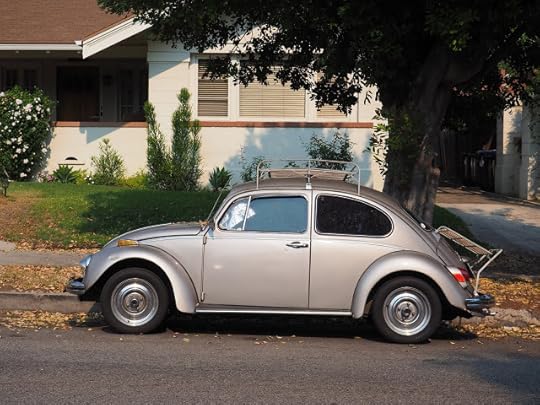
The palm trees (and also, the giant euphorbia and the hard to fathom parking sign):
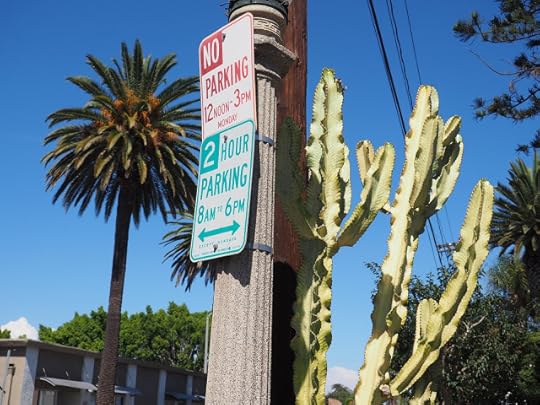
The cacti:

The stone lions
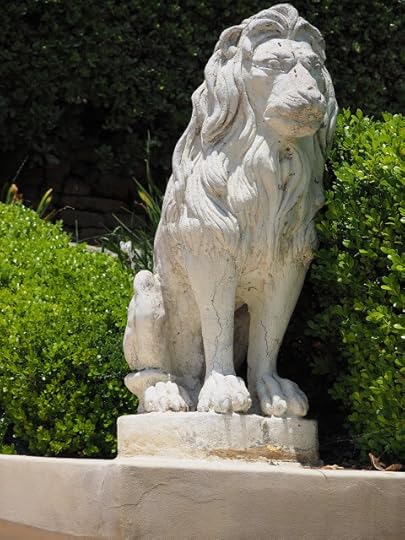
The bears:
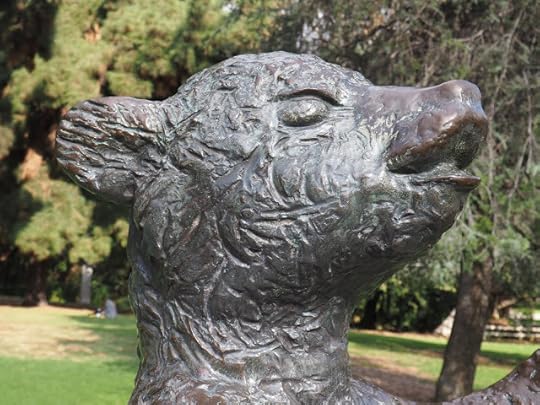
The curious skies:

Yep, all very LA indeed, but hold on there you psychogeographers, I found examples of all these things in England.
The classic Volkswagen beetles:
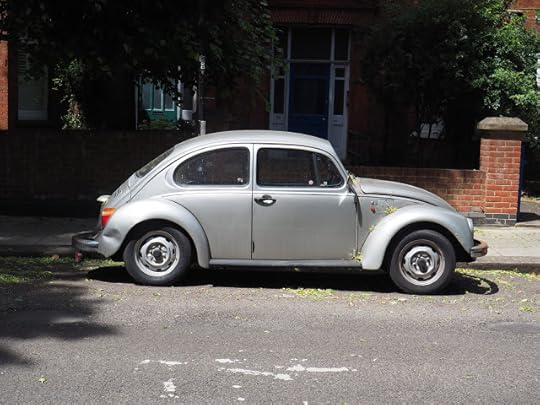
The palm trees (Is this the result of global warming? I don’t think there used to be so many palm trees in England):

The cacti:

The stone lions:
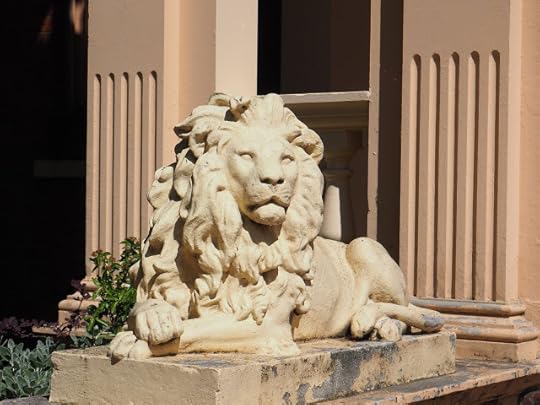
The bears:
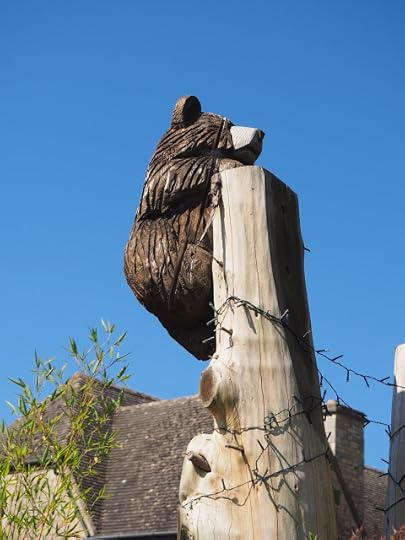
The curious skies:
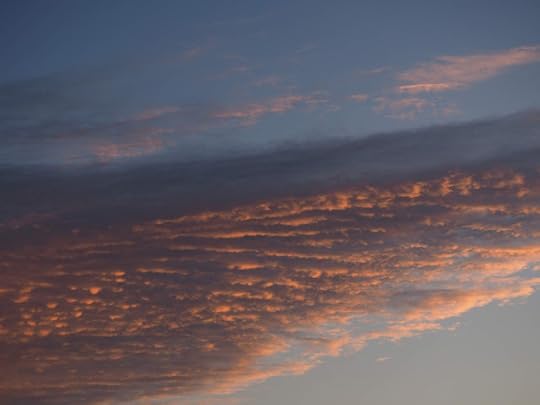
Globalizaton, innit? Possibly.

Published on August 10, 2018 17:01
August 7, 2018
POETS WALKING
Nobody seriously doubts that there’s a vital connection between walking and poetry. Not even me, although I do sometimes struggle to grasp what most contemporary poetry is “for.”
There is, I'm told, a rather good book on the subject, edited by David Kennedy, titled Necessary Steps: Poetry, Elegy, Walking, Spirit. It contains an essay by Jeremy Noel-Tod , “Walking the Yellow Brick Road: A Pedestrian Account of J. H. Prynne's Poems.”
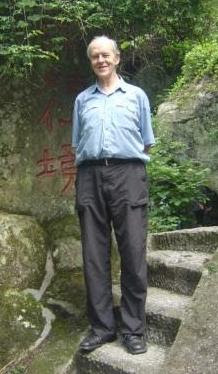
As some of you may know, JH Prynne, or Jeremy as I always called him, was my Director of Studies at university, and he taught me a great deal about poetry. His own poetry is not a walk in the park by any means, but I do occasionally read his work as a kind of intellectual and linguistic cage-fighting. But here’s what I think are some pretty great lines by Prynne from the poem the “Holy City”
There’s no mystic moment involved just
that we are
is how, each
severally, we’re
carried into
the wind which makes no decision and is
a tide, not taken. I saw it
and love is
when, how &
because we
do: you
could call it Ierusalem or feel it
as you walk, even quite jauntily, over the grass.*When I was prose editor at Ambit magazine, great swathes of poetry arrived as submissions on a daily basis, far more than the prose, and I was very glad indeed that I didn’t have to deal with all those poems.
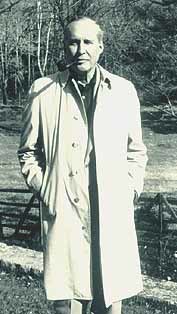
Still, here’s one poem that Ambit published, and I remember it fondly, by James Laughlin, founder of New Directions Publishing, as well as a poet.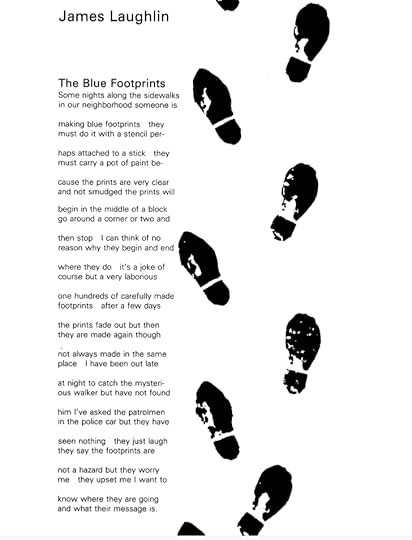
I’m pretty sure Jeremy Prynne would not approve of James Laughlin’s work, I think he'd find it lacking in rigor, although they were both admirers of Ezra Pound – back in the days which such a thing was much more permissible than it is now. Here's a poem by Pound.
Ione, Dead the Long Year Empty are the ways,
Empty are the ways of this land
And the flowers
Bend over with heavy heads.
They bend in vain.
Empty are the ways of this land
Where Ione
Walked once, and now does not walk
But seems like a person just gone.
*And here's old Ezra walking.


There is, I'm told, a rather good book on the subject, edited by David Kennedy, titled Necessary Steps: Poetry, Elegy, Walking, Spirit. It contains an essay by Jeremy Noel-Tod , “Walking the Yellow Brick Road: A Pedestrian Account of J. H. Prynne's Poems.”

As some of you may know, JH Prynne, or Jeremy as I always called him, was my Director of Studies at university, and he taught me a great deal about poetry. His own poetry is not a walk in the park by any means, but I do occasionally read his work as a kind of intellectual and linguistic cage-fighting. But here’s what I think are some pretty great lines by Prynne from the poem the “Holy City”
There’s no mystic moment involved just
that we are
is how, each
severally, we’re
carried into
the wind which makes no decision and is
a tide, not taken. I saw it
and love is
when, how &
because we
do: you
could call it Ierusalem or feel it
as you walk, even quite jauntily, over the grass.*When I was prose editor at Ambit magazine, great swathes of poetry arrived as submissions on a daily basis, far more than the prose, and I was very glad indeed that I didn’t have to deal with all those poems.

Still, here’s one poem that Ambit published, and I remember it fondly, by James Laughlin, founder of New Directions Publishing, as well as a poet.

I’m pretty sure Jeremy Prynne would not approve of James Laughlin’s work, I think he'd find it lacking in rigor, although they were both admirers of Ezra Pound – back in the days which such a thing was much more permissible than it is now. Here's a poem by Pound.
Ione, Dead the Long Year Empty are the ways,
Empty are the ways of this land
And the flowers
Bend over with heavy heads.
They bend in vain.
Empty are the ways of this land
Where Ione
Walked once, and now does not walk
But seems like a person just gone.
*And here's old Ezra walking.


Published on August 07, 2018 13:49
August 1, 2018
WALKING STICK WISDOM
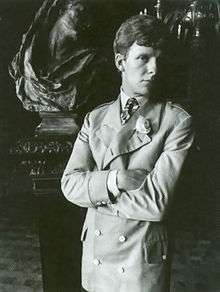
I’ve been reading the obituaries of Christopher Gibbs (that's him above), once described by James Delingpole as “the great civilising influence of the high 1960s counterculture. He got the formerly loutish Rolling Stones into velvet suits, Islamic art and stately homes; he thought up the album title Beggars Banquet; he stood up for his friends Mick Jagger and Marianne Faithfull after the infamous Redlands drugs bust; he designed the film sets for Nicolas Roeg and Donald Cammell's Performance, inventing the elegantly dilapidated interior style later known as 'shabby chic'.”

Well, that’s a full life isn't it? He also was an old Etonian (expelled – as was the style at the time) and, if you ask me, just one more of those figures who gives the lie to the notion that “the Sixties,” however defined, was a working class phenomenon.
In an interview with House and Garden he once said, “'I like people to collect and buy things which have a strong personal flavour of someone gone by. For example, walking sticks. You can walk into a frightfully ugly house and the most strongly personal and tangy corner of it is the walking-stick stand in the hall. Its sticks have been given by people to each other, they chronicle events.”
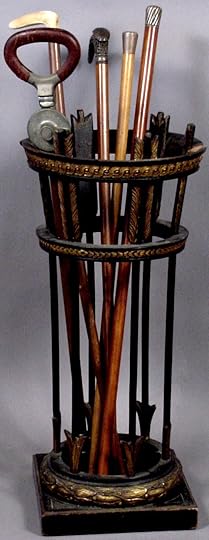
I’m not sure I’ve ever walked into a house that had a walking stick stand in the hall, (maybe my former parents in law?), but I know what he means and I like it a lot. Walking adds patina to just about anything.
His obit in the London Times said, “His final destination was Tangier, where he established an elegant home and garden on one of the mountain slopes overlooking the Strait of Gibraltar. One visitor described him there as ‘wearing wonderful kaftans’, adding: ‘And he looked like Moses walking in the olive garden — very peaceful.’" This is him below in that phase, though I never imagined Moses as a blond.
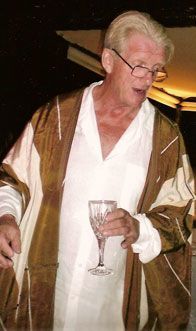
I do not have an olive garden, and I don’t wear kaftans, but I do have a single olive plant in the garden (it’s not quite a tree) and I walk by it every day and sometimes I think I should be doing something about more to/about/for it. So I consulted the internet about the care and pruning of olive tress. One of the best sites I found said, “Do nothing for the first fifty years.” Yeah, I can handle that.
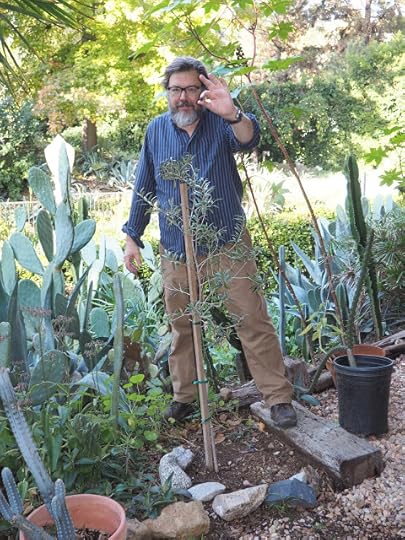
Yep, that’s me above and my olive plant, and yes I’m holding up an olive it produced. Do I resemble Moses? You decide.

Published on August 01, 2018 19:59
July 26, 2018
"BALLARDIAN" AIRPORT MELANCHOLIA
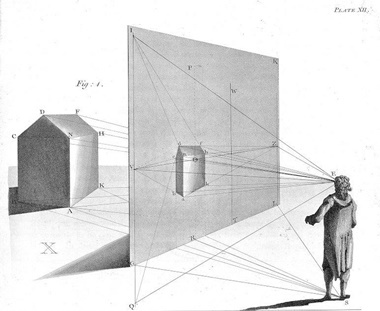
Until last month I had only ever once stayed in an airport hotel – it was in Los Angeles when Virgin couldn’t fly us out. At this point I’ve forgotten both the reason and the name of the hotel.
But last month in order to get an affordable flight from Heathrow I had to take off very early in the morning, in fact so early that I doubted I could get to the airport from central London in time. So for the night before the flight I booked into the Hyatt Place Heathrow – very clean, very neat, not quite as soulless as you might expect (though it does look it in the picture below), and pretty cheap for a “London hotel.”

Obsessive and travel-anxious as I always am, I arrived there mid-afternoon and once I’d checked in, despite the place not being entirely soulless, a profound “in transit” melancholy descended upon me. So I decided to go for a walk.
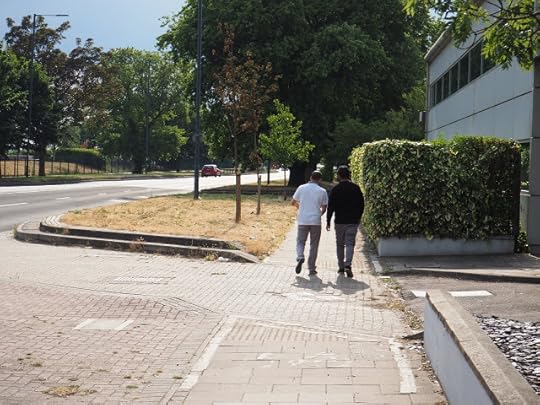
I imagined I’d be plodding around the perimeter fences of various ancillary airport buildings - which was OK by me - but this proved not be the case. A little way down the main drag – which is named Bath Road - there was a stile that led into a wheat field. And there was a very clear path leading straight across it. Off I went.
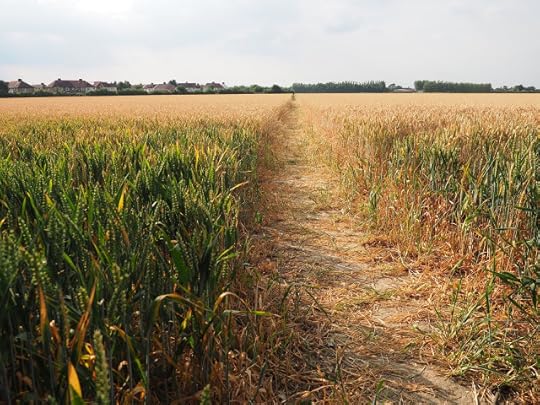
Now it so happened that when I was in London I’d seen an exhibition at the Royal Institute of British Architects, titled “Disappear Here: On perspective and other kinds of space” curated by Sam Jacobs.
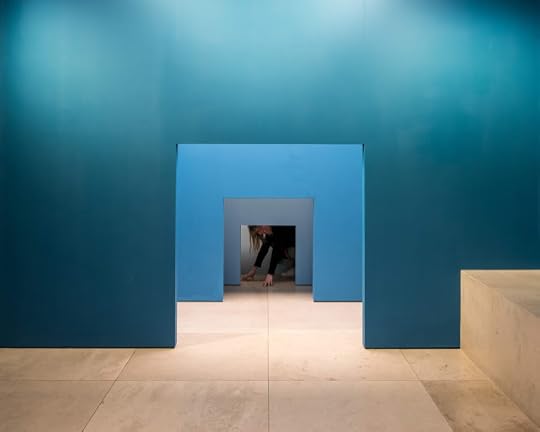
So I knew a thing or two about vanishing points. And this field offered more than one of them. Cool.

That exhibition title, I assume, must derive from Bret Easton Ellis’s novel Less Than Zero. The words first appear in this section:“I come to a red light, tempted to go through it, then stop once I see a billboard sign that I don't remember seeing and I look up at it. All it says is ‘Disappear Here’ and even though it's probably an ad for some resort, it still freaks me out a little and I step on the gas really hard and the car screeches as I leave the light."
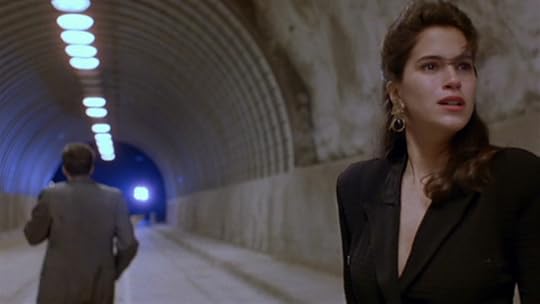
The phrase “disappear here” keeps popping up throughout the novel, which seemed a pretty weary trope when I first read the novel in the 1980s and it doesn’t seem any less so now.
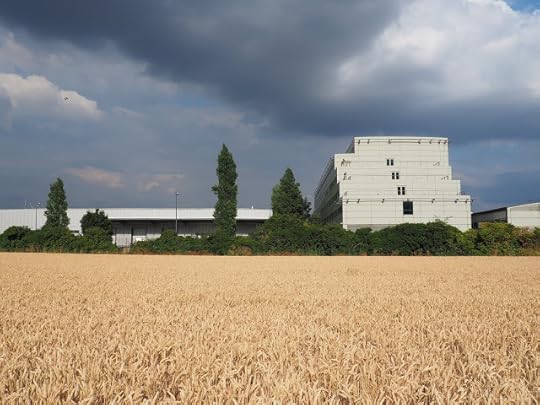
But anyway, as I continued to walk through the wheat field I started to hear guns in the distance. I couldn’t see anybody doing the shooting, and this being England, I assumed it was a farmer using his shotgun, attempting to kill crows rather than me, but when you’re in the middle of a field in the edgelands of Heathrow airport, with no cover for a few hundred yards in all directions, it’s probably best not to take anything for granted. I rereated. I lived to tell the tale. You knew that already.
Various people I’ve described this experience to have said how “Ballardian” it must have felt. Well only up to a point. JG Ballard is on record as saying how wonderful he found the Heathrow Hilton. In an interview with Hans Ulrich Obrist, Ballard said,
“The Heathrow Hilton designed by Michael Manser is my favourite building in London. It's part space-age hangar and part high-tech medical centre. It's clearly a machine, and the spirit of Le Corbusier lives on in its minimal functionalism. It's a white cathedral, almost a place of worship, the closest to a religious building that you can find in an airport. Inside, it's a highly theatrical space, dominated by its immense atrium. The building, in effect, is an atrium with a few rooms attached. Most hotels are residential structures, but rightly the Heathrow Hilton plays down this role, accepting the total transience that is its essence, and instead turns itself into a huge departure lounge, as befits an airport annexe. Sitting in its atrium one becomes, briefly, a more advanced kind of human being. Within this remarkable building one feels no emotions and could never fall in love, or need to.”

Well again, only up to a point, surely. In any case, the Heathrow Hilton, more architectural than the Hyatt, though it undoubtedly is, costs about three times as much as my room at the Hyatt. Would the extra expense have defused my melancholy? You know, I doubt it.

Published on July 26, 2018 21:24
July 19, 2018
CAN I GO TO THE BRIDGE?
If you’ve read my novel Bleeding London (and I suppose it’s just possible that some of you have) you may have noticed one glaring error. I’m not saying it’s the only one but it’s the one I’ve been told about. I say in the book that Hornsey Lane Bridge, which runs high above Archway Road is a railway bridge – it isn’t and I should have known that.

The more important thing to know (and this is in the book), is that it’s a famous “suicide bridge” – a place where people launch themselves into space, down to the road and traffic below.
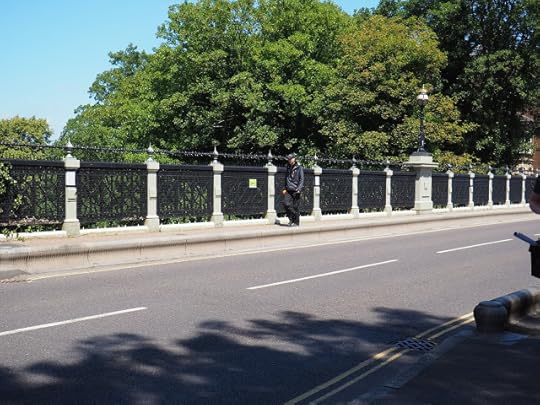
So in a very small literary penance, and many years after the event, I decided I’d walk both across and under Hornsey Lane Bridge As you walk along it, it really doesn’t seem very threatening or scary. People walk or drive or cycle across it and thoughts of death don’t immediately spring to mind, though you may notice it’s a long way down to the road below.


A bit or research reveals that there have long been plans to build anti-suicide features, including a net, but I didn’t see any sign of that. Sure there were railings and spikes that would make it harder and more unpleasant to get in position to jump, but I don’t think these things would deter the determined suicidalist. Then again, I suppose even if they deter one or two casual jumpers, then they’re still doing a job.
There are also various notices, attached to the bridge with phone numbers that you’re invited to call if you’re feeling suicidal. Presumably somebody at the other end tries to talk you out of it, though not having called the numbers I can‘t absolutely swear to that.
There were two other remarkable things on the bridge. First this warning sign telling you to avoid whatever electrical gubbins are beneath that metal cover. Now, I’m no expert but I’d have thought death by electrocution might be an easier option than death by jumping off a bridge, but this is no doubt debatable.

Secondly, this war memorial commemorating servicemen who attended Saint Alosyius College which is just at the western end of the bridge. (FYI - the fictional Tony Hancock was named “Anthony Aloysius St John Hancock.") There’s our Lord upon the cross and nearer ground level there’s a certain amount of foot love going on, which I think might be biblically dubious, but I’m sure some would think it’s the kind of thing that might make life worth living.


Walking down below in Archway Road, and looking up, the bridge was far more impressive than I remembered it, and considerably grander than it seemed when walking across it. It’s a fine bit of Victorian engineering, it's the work of Sir Alexander Binnie who also designed Vauxhall Bridge.
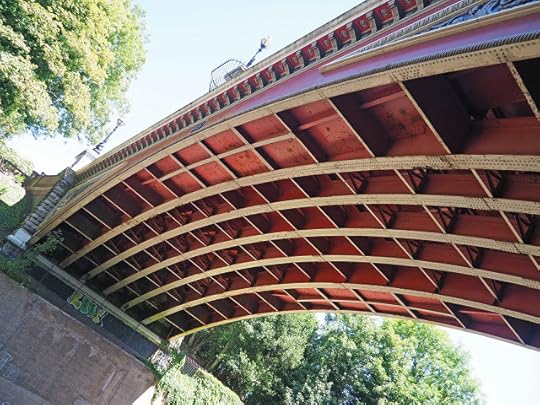
You're likely to see some other interesting stuff as you walk along Archway Road . My eye was caught by this house that apparently had to be completely reconfigured to accommodate Archway Road:
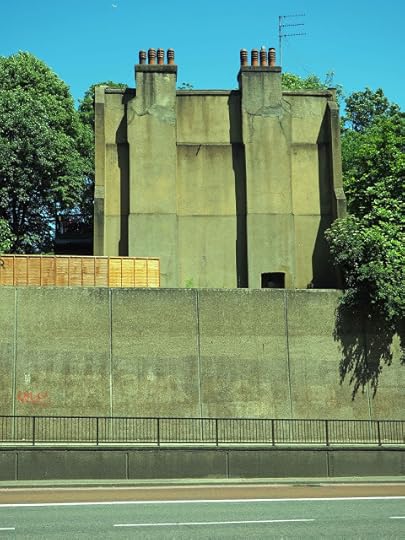
And a gun shop. But hey, this is England, they’re not going to sell you anything you’re likely to be able to kill yourself with.
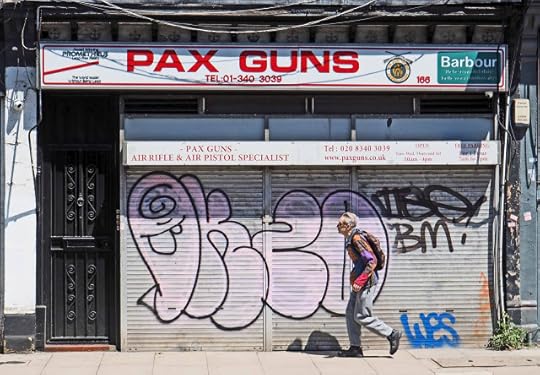


The more important thing to know (and this is in the book), is that it’s a famous “suicide bridge” – a place where people launch themselves into space, down to the road and traffic below.

So in a very small literary penance, and many years after the event, I decided I’d walk both across and under Hornsey Lane Bridge As you walk along it, it really doesn’t seem very threatening or scary. People walk or drive or cycle across it and thoughts of death don’t immediately spring to mind, though you may notice it’s a long way down to the road below.


A bit or research reveals that there have long been plans to build anti-suicide features, including a net, but I didn’t see any sign of that. Sure there were railings and spikes that would make it harder and more unpleasant to get in position to jump, but I don’t think these things would deter the determined suicidalist. Then again, I suppose even if they deter one or two casual jumpers, then they’re still doing a job.
There are also various notices, attached to the bridge with phone numbers that you’re invited to call if you’re feeling suicidal. Presumably somebody at the other end tries to talk you out of it, though not having called the numbers I can‘t absolutely swear to that.
There were two other remarkable things on the bridge. First this warning sign telling you to avoid whatever electrical gubbins are beneath that metal cover. Now, I’m no expert but I’d have thought death by electrocution might be an easier option than death by jumping off a bridge, but this is no doubt debatable.

Secondly, this war memorial commemorating servicemen who attended Saint Alosyius College which is just at the western end of the bridge. (FYI - the fictional Tony Hancock was named “Anthony Aloysius St John Hancock.") There’s our Lord upon the cross and nearer ground level there’s a certain amount of foot love going on, which I think might be biblically dubious, but I’m sure some would think it’s the kind of thing that might make life worth living.


Walking down below in Archway Road, and looking up, the bridge was far more impressive than I remembered it, and considerably grander than it seemed when walking across it. It’s a fine bit of Victorian engineering, it's the work of Sir Alexander Binnie who also designed Vauxhall Bridge.

You're likely to see some other interesting stuff as you walk along Archway Road . My eye was caught by this house that apparently had to be completely reconfigured to accommodate Archway Road:

And a gun shop. But hey, this is England, they’re not going to sell you anything you’re likely to be able to kill yourself with.


Published on July 19, 2018 13:10
July 14, 2018
WALKING WITH WOOLF

I’m sure I’ve said it before, probably on this blog, that Virginia Woolf, walker though she may well have been, is not an open book to me. Nevertheless I happened to come across a paperback copy of her A Writer’s Diary, opened it pretty much at random and immediately found this passage:Monday October 25th, 1920“Why is life so tragic: so like a little strip of pavement over an abyss. I look down; I feel giddy; I wonder how I am ever to walk to the end.”
I thought that was a pretty good find. So imagine my angst on discovering that a version of that quotation is all over the interwebs, often superimposed on some cutesy New Agey background.
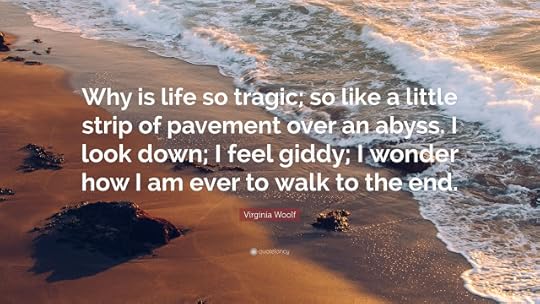
Enough to make you want to walk into a river, almost.
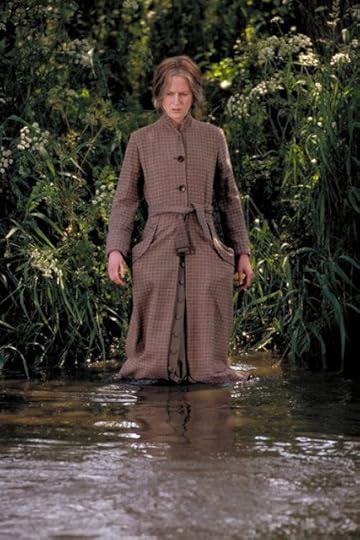

Published on July 14, 2018 17:28
July 8, 2018
WALKING WITH FURIES
I was staying in London for three weeks last month, in West Hampstead, an area where I used to live a long time ago. Even back then I considered myself a pretty good urban walker, and I certainly explored the neighborhood, but walking around there last month it seemed a very different place. Of course, some of it was because the neighborhood has changed, gentrified I suppose you’d say, although it was never exactly the mean streets. But maybe it’s also because I’ve become a different kind of walker, more thorough, more observant, and maybe just a little more intrepid.
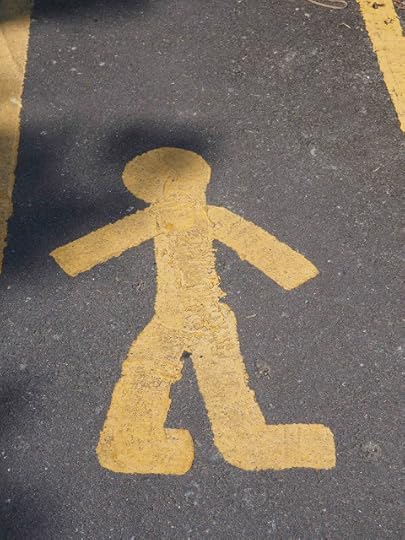
Take Billy Fury Way, for instance. Back in the day it was a scary, and I think nameless, alley running alongside the railway line from West End Lane to Finchley Road. It looked like a place you wouldn't walk unless you wanted to take your life in your hands, and there are still reports of dodgy goings on there. In fact, dedicating the alley to Billy Fury was part of the effort to make it less scary. This happened in 2010.

It seems to me that Billy Fury, real name Ronald Wycherley, had a fairly tenuous connection to West Hampstead, even if he recorded at Decca Studios in Broadhurst Gardens. Nevertheless, a year after the name change, a mural of Billy’s face was painted on a wall at the entrance to his "way," in the hopes of encouraging the better sort of street artists to express themselves nearby. This was a limited success. Before too long Billy’s face was tagged and desecrated, and the powers that be painted him over, reduced the wall to a black expanse to save further embarrassment. I’m sure it needs a lot of repainting and touching up, but at least the entrance was looking more or less unsullied when I pitched up at my digs in West Hampstead.
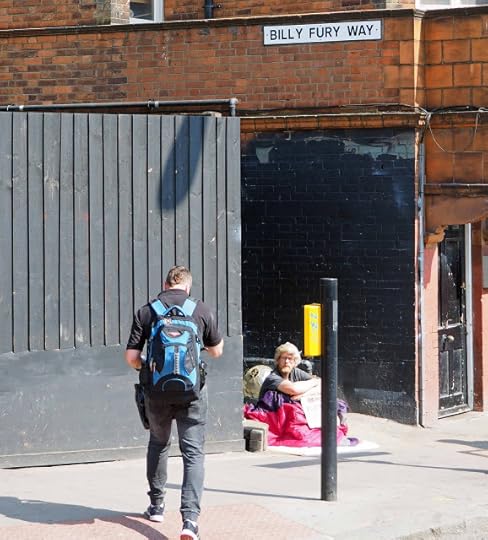
In my wanderings I also came across Black Path, running along the railway lines tracks in the opposite direction from Billy Fury Way. It lived up to its name in that the walls and fences along it were painted black, and it seemed remarkably free of graffiti, though again there was plenty of evidence of repainting and touching up.
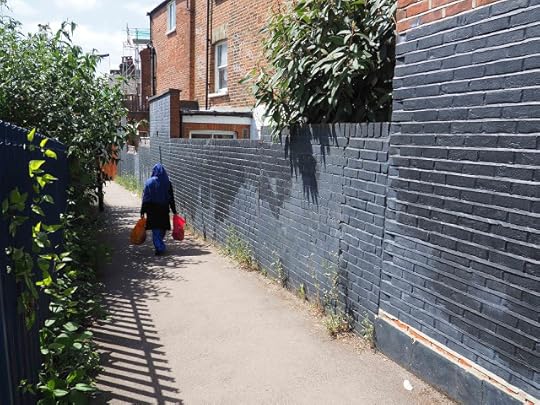
I also discovered Wayne Kirkum Way, the entrance to which is more or less caged, and therefore feels intimidating as much as protective. Of course I had never heard of Wayne Kirkum but a little research revealed that he was a young lad who’d been killed on the nearby railways line. This was some 30 years ago, and the internet is inevitably thin on detail. Hold that thought.
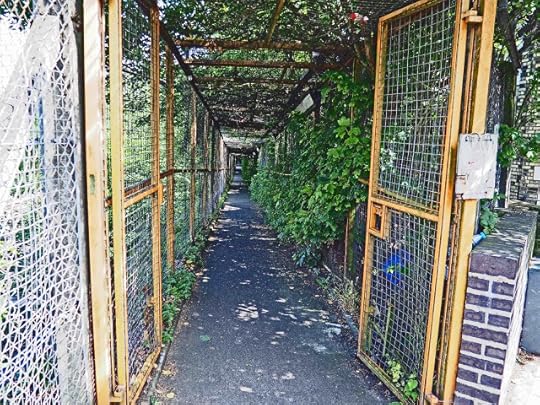
After I’d been staying in West Hampstead for a while, some new, strange, and very specific tags started to appear all over the place, including the spot where Billy Fury’s face had been. It was no longer a black expanse.

Maybe it was naive of me but I didn’t immediately read RIP as Rest In Peace, but that was certainly what it meant. In due course the story came out in the newspapers. Three taggers – Trip, Lover, and K-Bag - had died, been hit by a train on the railway line close to Brixton station while plying their art.
I don’t know if there’s any such think as a “typical” tagger, but these guys didn’t seem to fit the stereotype. Their names were Harrison Scott-Hood – he was Lover, Jack Gilbert was K-Bag, Alberto Carrasco was Trip. The first two were twenty-three years old, and Trip was the son of the London correspondent for El Mundo - it turned out that he'd been at sixth form college with the daughter of a friend of mine; so not exactly the deprived bad lads from the council estate.
It’s not hard to see the attraction of walking where you shouldn’t, of committing urban trespass, putting your tag in the riskiest, most inaccessible places. Still, it seems rather a trivial thing to die for, which of course makes the deaths more, not less, tragic. One can only imagine what the families are going through.
The graffiti community (for want of a better term) expressed its commiserations all over the city. The picture below was taken at 7.15 on the morning of Tuesday, June 26th. I walked past it again at 11 am, and the graffiti had been painted over, creating another black expense.
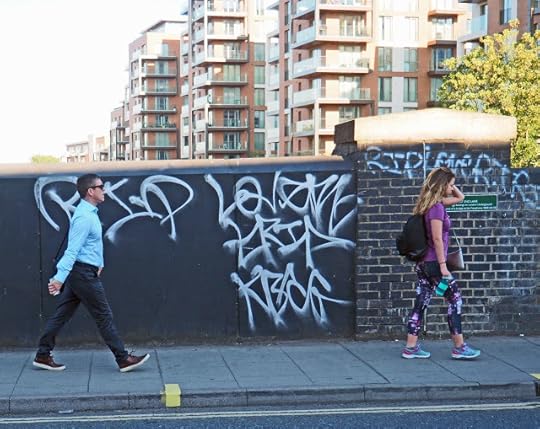


Take Billy Fury Way, for instance. Back in the day it was a scary, and I think nameless, alley running alongside the railway line from West End Lane to Finchley Road. It looked like a place you wouldn't walk unless you wanted to take your life in your hands, and there are still reports of dodgy goings on there. In fact, dedicating the alley to Billy Fury was part of the effort to make it less scary. This happened in 2010.

It seems to me that Billy Fury, real name Ronald Wycherley, had a fairly tenuous connection to West Hampstead, even if he recorded at Decca Studios in Broadhurst Gardens. Nevertheless, a year after the name change, a mural of Billy’s face was painted on a wall at the entrance to his "way," in the hopes of encouraging the better sort of street artists to express themselves nearby. This was a limited success. Before too long Billy’s face was tagged and desecrated, and the powers that be painted him over, reduced the wall to a black expanse to save further embarrassment. I’m sure it needs a lot of repainting and touching up, but at least the entrance was looking more or less unsullied when I pitched up at my digs in West Hampstead.

In my wanderings I also came across Black Path, running along the railway lines tracks in the opposite direction from Billy Fury Way. It lived up to its name in that the walls and fences along it were painted black, and it seemed remarkably free of graffiti, though again there was plenty of evidence of repainting and touching up.

I also discovered Wayne Kirkum Way, the entrance to which is more or less caged, and therefore feels intimidating as much as protective. Of course I had never heard of Wayne Kirkum but a little research revealed that he was a young lad who’d been killed on the nearby railways line. This was some 30 years ago, and the internet is inevitably thin on detail. Hold that thought.

After I’d been staying in West Hampstead for a while, some new, strange, and very specific tags started to appear all over the place, including the spot where Billy Fury’s face had been. It was no longer a black expanse.

Maybe it was naive of me but I didn’t immediately read RIP as Rest In Peace, but that was certainly what it meant. In due course the story came out in the newspapers. Three taggers – Trip, Lover, and K-Bag - had died, been hit by a train on the railway line close to Brixton station while plying their art.
I don’t know if there’s any such think as a “typical” tagger, but these guys didn’t seem to fit the stereotype. Their names were Harrison Scott-Hood – he was Lover, Jack Gilbert was K-Bag, Alberto Carrasco was Trip. The first two were twenty-three years old, and Trip was the son of the London correspondent for El Mundo - it turned out that he'd been at sixth form college with the daughter of a friend of mine; so not exactly the deprived bad lads from the council estate.
It’s not hard to see the attraction of walking where you shouldn’t, of committing urban trespass, putting your tag in the riskiest, most inaccessible places. Still, it seems rather a trivial thing to die for, which of course makes the deaths more, not less, tragic. One can only imagine what the families are going through.
The graffiti community (for want of a better term) expressed its commiserations all over the city. The picture below was taken at 7.15 on the morning of Tuesday, June 26th. I walked past it again at 11 am, and the graffiti had been painted over, creating another black expense.


Published on July 08, 2018 17:44
June 3, 2018
WANDERING STILL
“London the secular city instructs him: turn any corner and he can find himself inside a parable.”
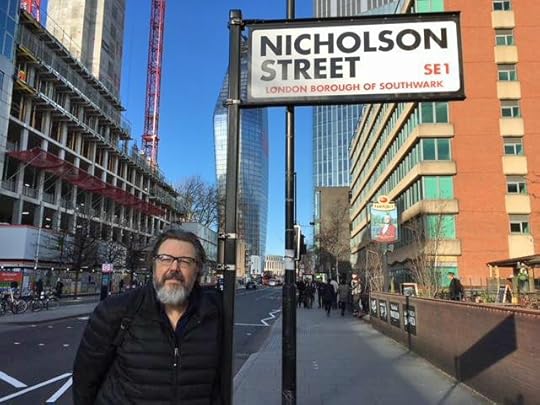
I’ll be away in London for the next month or so, walking of course. Don’t worry, I won’t become a stranger.

I’ll be away in London for the next month or so, walking of course. Don’t worry, I won’t become a stranger.

Published on June 03, 2018 12:37
Geoff Nicholson's Blog
- Geoff Nicholson's profile
- 55 followers
Geoff Nicholson isn't a Goodreads Author
(yet),
but they
do have a blog,
so here are some recent posts imported from
their feed.



